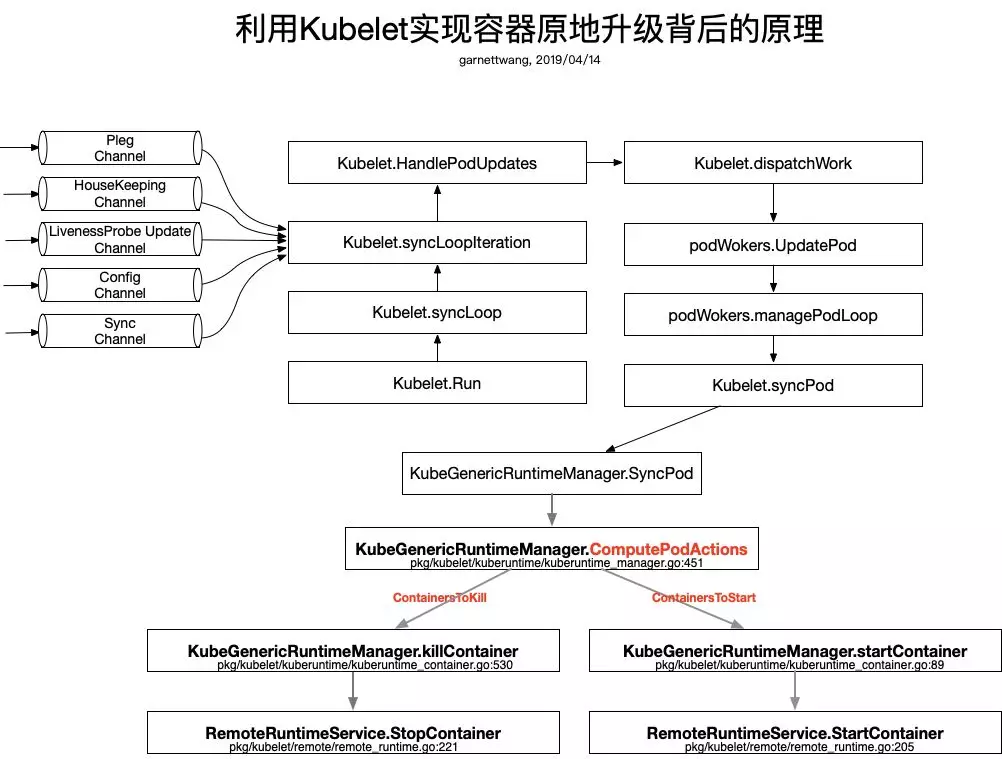在 Kubernetes 中,Pod 是调度的基本单元,也是所有内置 Workload 管理的基本单元,无论是 Deployment 还是 StatefulSet,它们在对管理的应用进行更新时,都是以 Pod 为单位,Pod 作为 Immutable Unit。然而,在部署业务时,Pod 中除了业务容器,经常会有一个甚至多个 SideCar Container,如何在不影响业务 Container 的情况下,完成对 SideCar Container 的原地升级呢,这正是本文需要探讨的技术实现。
本文基于 Kubernetes 1.12 撰写
为什么需要容器的原地升级
在 Docker 的世界,容器镜像作为不可变基础设施,解决了环境依赖的难题,而 Kubernetes 将这提升到了 Pod 的高度,希望每次应用的更新都通过 ReCreate Pod 的方式完成,这个理念是非常好的,这样每次 ReCreate 都是全新的、干净的应用环境。对于微服务的部署,这种方式并没有带来多大的负担,而对于传统应用的部署,一个 Pod 中可能包含了主业务容器,还有不可剥离的依赖业务容器,以及 SideCar 组件容器等,这时的 Pod 就显得很臃肿了,如果因为要更新其中一个 SideCar Container 而继续按照 ReCreate Pod 的方式进行整个 Pod 的重建,那负担还是很大的,体现在:
因此,因为要更新一个轻量的 SideCar 却导致了分钟级的单个 Pod 的重建过程,如果应用副本数高达成百上千,那么整体耗费时间可想而知,如果是使用 StatefulSet OrderedReady PodManagementPolicy 进行更新的,那代价就是难于接受的。
因此,我们迫切希望能实现,只升级 Pod 中的某个 Container,而不用重建整个 Pod,这就是我们说的容器原地升级能力。
Kubernetes 是否已经支持 Container 原地升级
答案是:支持!其实早在两年都前的 Kubernetes v1.5 版本就有了对应的代码逻辑,本文以 Kubernetes 1.12 版本的代码进行解读。
很多同学肯定会觉得可疑,Kubernetes 中连真正的 ReStart 都没有,都是 ReCreate Pod,怎么会只更新 Container 呢?没错,在内置的众多 Workload 的 Controller 的逻辑中,确实如此。Kubernetes 把容器原地升级的能力只做在 Kubelet 这一层,并没有暴露在 Deployment、StatefulSet 等 Controller 中直接提供给用户,原因很简单,还是建议大家把 Pod 作为完整的部署单元。
Kubelet 启动后通过 syncLoop 进入到主循环处理 Node 上 Pod Changes 事件,监听来自 file,apiserver,http 三类的事件并汇聚到 kubetypes.PodUpdate Channel(Config Channel)中,由 syncLoopIteration 不断从 kubetypes.PodUpdate Channel 中消费。
pkg/kubelet/kubelet.go:1870
func (kl *Kubelet) syncLoopIteration(configCh <-chan kubetypes.PodUpdate, handler SyncHandler, syncCh <-chan time.Time, housekeepingCh <-chan time.Time, plegCh <-chan *pleg.PodLifecycleEvent) bool { select { case u, open := <-configCh: ... switch u.Op { ... case kubetypes.UPDATE: glog.V(2).Infof("SyncLoop (UPDATE, %q): %q", u.Source, format.PodsWithDeletionTimestamps(u.Pods)) handler.HandlePodUpdates(u.Pods) ... ... }...}
复制代码
在 managePodLoop 中调用 Kubelet.syncPod 进行 Pod 的 sync 处理。
Kubelet.syncPod 中会根据需求进行 Pod 的 Kill、Cgroup 的设置、为 Static Pod 创建 Mirror Pod、为 Pod 创建 data directories、等待 Volume 挂载等工作,最重要的还会调用 KubeGenericRuntimeManager.SyncPod 进行 Pod 的状态维护和干预操作。
KubeGenericRuntimeManager.SyncPod 确保 Running Pod 处于期望状态,主要执行以下操作。容器原地升级背后的核心原理就从这里开始。
1.Compute sandbox and container changes.
2.Kill pod sandbox if necessary.
3.Kill any containers that should not be running.
4.Create sandbox if necessary.
5.Create init containers.
6.Create normal containers.
KubeGenericRuntimeManager.SyncPod 中首先调用
kubeGenericRuntimeManager.computePodActions 检查 Pod Spec 是否发生变更,并且返回 PodActions,记录为了达到期望状态需要执行的变更内容。
pkg/kubelet/kuberuntime/kuberuntime_manager.go:451
// computePodActions checks whether the pod spec has changed and returns the changes if true.func (m *kubeGenericRuntimeManager) computePodActions(pod *v1.Pod, podStatus *kubecontainer.PodStatus) podActions { glog.V(5).Infof("Syncing Pod %q: %+v", format.Pod(pod), pod)
createPodSandbox, attempt, sandboxID := m.podSandboxChanged(pod, podStatus) changes := podActions{ KillPod: createPodSandbox, CreateSandbox: createPodSandbox, SandboxID: sandboxID, Attempt: attempt, ContainersToStart: []int{}, ContainersToKill: make(map[kubecontainer.ContainerID]containerToKillInfo), }
// If we need to (re-)create the pod sandbox, everything will need to be // killed and recreated, and init containers should be purged. if createPodSandbox { if !shouldRestartOnFailure(pod) && attempt != 0 { // Should not restart the pod, just return. return changes } if len(pod.Spec.InitContainers) != 0 { // Pod has init containers, return the first one. changes.NextInitContainerToStart = &pod.Spec.InitContainers[0] return changes } // Start all containers by default but exclude the ones that succeeded if // RestartPolicy is OnFailure. for idx, c := range pod.Spec.Containers { if containerSucceeded(&c, podStatus) && pod.Spec.RestartPolicy == v1.RestartPolicyOnFailure { continue } changes.ContainersToStart = append(changes.ContainersToStart, idx) } return changes } // Check initialization progress. initLastStatus, next, done := findNextInitContainerToRun(pod, podStatus) if !done { if next != nil { initFailed := initLastStatus != nil && isContainerFailed(initLastStatus) if initFailed && !shouldRestartOnFailure(pod) { changes.KillPod = true } else { changes.NextInitContainerToStart = next } } // Initialization failed or still in progress. Skip inspecting non-init // containers. return changes }
// Number of running containers to keep. keepCount := 0 // check the status of containers. for idx, container := range pod.Spec.Containers { containerStatus := podStatus.FindContainerStatusByName(container.Name)
// Call internal container post-stop lifecycle hook for any non-running container so that any // allocated cpus are released immediately. If the container is restarted, cpus will be re-allocated // to it. if containerStatus != nil && containerStatus.State != kubecontainer.ContainerStateRunning { if err := m.internalLifecycle.PostStopContainer(containerStatus.ID.ID); err != nil { glog.Errorf("internal container post-stop lifecycle hook failed for container %v in pod %v with error %v", container.Name, pod.Name, err) } } // If container does not exist, or is not running, check whether we // need to restart it. if containerStatus == nil || containerStatus.State != kubecontainer.ContainerStateRunning { if kubecontainer.ShouldContainerBeRestarted(&container, pod, podStatus) { message := fmt.Sprintf("Container %+v is dead, but RestartPolicy says that we should restart it.", container) glog.V(3).Infof(message) changes.ContainersToStart = append(changes.ContainersToStart, idx) } continue } // The container is running, but kill the container if any of the following condition is met. reason := "" restart := shouldRestartOnFailure(pod) if expectedHash, actualHash, changed := containerChanged(&container, containerStatus); changed { reason = fmt.Sprintf("Container spec hash changed (%d vs %d).", actualHash, expectedHash) // Restart regardless of the restart policy because the container // spec changed. restart = true } else if liveness, found := m.livenessManager.Get(containerStatus.ID); found && liveness == proberesults.Failure { // If the container failed the liveness probe, we should kill it. reason = "Container failed liveness probe." } else { // Keep the container. keepCount += 1 continue } // We need to kill the container, but if we also want to restart the // container afterwards, make the intent clear in the message. Also do // not kill the entire pod since we expect container to be running eventually. message := reason if restart { message = fmt.Sprintf("%s. Container will be killed and recreated.", message) changes.ContainersToStart = append(changes.ContainersToStart, idx) } changes.ContainersToKill[containerStatus.ID] = containerToKillInfo{ name: containerStatus.Name, container: &pod.Spec.Containers[idx], message: message, } glog.V(2).Infof("Container %q (%q) of pod %s: %s", container.Name, containerStatus.ID, format.Pod(pod), message) } if keepCount == 0 && len(changes.ContainersToStart) == 0 { changes.KillPod = true } return changes}
复制代码
computePodActions 会检查 Pod Sandbox 是否发生变更、各个 Container(包括 InitContainer)的状态等因素来决定是否要重建整个 Pod。
遍历 Pod 内所有 Containers:
如果容器还没启动,则会根据 Container 的重启策略决定是否将 Container 添加到待启动容器列表中(PodActions.ContainersToStart);
如果容器的 Spec 发生变更(比较 Hash 值),则无论重启策略是什么,都要根据新的 Spec 重建容器,将 Container 添加到待启动容器列表中
(PodActions.ContainersToStart);
如果 Container Spec 没有变更,liveness probe 也是成功的,则该 Container 将保持不动,否则会将容器将入到待 Kill 列表中(PodActions.ContainersToKill);
PodActions 表示要对 Pod 进行的操作信息:
pkg/kubelet/kuberuntime/kuberuntime_manager.go:369
// podActions keeps information what to do for a pod.type podActions struct { // Stop all running (regular and init) containers and the sandbox for the pod. KillPod bool // Whether need to create a new sandbox. If needed to kill pod and create a // a new pod sandbox, all init containers need to be purged (i.e., removed). CreateSandbox bool // The id of existing sandbox. It is used for starting containers in ContainersToStart. SandboxID string // The attempt number of creating sandboxes for the pod. Attempt uint32
// The next init container to start. NextInitContainerToStart *v1.Container // ContainersToStart keeps a list of indexes for the containers to start, // where the index is the index of the specific container in the pod spec ( // pod.Spec.Containers. ContainersToStart []int // ContainersToKill keeps a map of containers that need to be killed, note that // the key is the container ID of the container, while // the value contains necessary information to kill a container. ContainersToKill map[kubecontainer.ContainerID]containerToKillInfo}
复制代码
因此,computePodActions 的关键是的计算出了待启动的和待 Kill 的容器列表。
接下来,KubeGenericRuntimeManager.SyncPod 就会在分别调用
KubeGenericRuntimeManager.killContainer
和 startContainer 去杀死和启动容器。
func (m *kubeGenericRuntimeManager) SyncPod(pod *v1.Pod, _ v1.PodStatus, podStatus *kubecontainer.PodStatus, pullSecrets []v1.Secret, backOff *flowcontrol.Backoff) (result kubecontainer.PodSyncResult) { // Step 1: Compute sandbox and container changes. podContainerChanges := m.computePodActions(pod, podStatus) ... // Step 2: Kill the pod if the sandbox has changed. if podContainerChanges.KillPod { ... } else { // Step 3: kill any running containers in this pod which are not to keep. for containerID, containerInfo := range podContainerChanges.ContainersToKill { glog.V(3).Infof("Killing unwanted container %q(id=%q) for pod %q", containerInfo.name, containerID, format.Pod(pod)) killContainerResult := kubecontainer.NewSyncResult(kubecontainer.KillContainer, containerInfo.name) result.AddSyncResult(killContainerResult) if err := m.killContainer(pod, containerID, containerInfo.name, containerInfo.message, nil); err != nil { killContainerResult.Fail(kubecontainer.ErrKillContainer, err.Error()) glog.Errorf("killContainer %q(id=%q) for pod %q failed: %v", containerInfo.name, containerID, format.Pod(pod), err) return } } } ... // Step 4: Create a sandbox for the pod if necessary. podSandboxID := podContainerChanges.SandboxID if podContainerChanges.CreateSandbox { ... } ... // Step 5: start the init container. if container := podContainerChanges.NextInitContainerToStart; container != nil { ... } // Step 6: start containers in podContainerChanges.ContainersToStart. for _, idx := range podContainerChanges.ContainersToStart { container := &pod.Spec.Containers[idx] startContainerResult := kubecontainer.NewSyncResult(kubecontainer.StartContainer, container.Name) result.AddSyncResult(startContainerResult) isInBackOff, msg, err := m.doBackOff(pod, container, podStatus, backOff) if isInBackOff { startContainerResult.Fail(err, msg) glog.V(4).Infof("Backing Off restarting container %+v in pod %v", container, format.Pod(pod)) continue } glog.V(4).Infof("Creating container %+v in pod %v", container, format.Pod(pod)) if msg, err := m.startContainer(podSandboxID, podSandboxConfig, container, pod, podStatus, pullSecrets, podIP, kubecontainer.ContainerTypeRegular); err != nil { startContainerResult.Fail(err, msg) // known errors that are logged in other places are logged at higher levels here to avoid // repetitive log spam switch { case err == images.ErrImagePullBackOff: glog.V(3).Infof("container start failed: %v: %s", err, msg) default: utilruntime.HandleError(fmt.Errorf("container start failed: %v: %s", err, msg)) } continue } } return}
复制代码
我们只关注整个流程中与容器原地升级原理相关的代码逻辑,对应的流程图如下:
验证
使用 StatefulSet 部署一个 Demo,然后修改某个 Pod 的 Spec 中 nginx 容器的镜像版本,通过 kubelet 日志可以发现的确如此。
kubelet[1121]: I0412 16:34:28.356083 1121 kubelet.go:1868] SyncLoop (UPDATE, "api"): "web-2_default(2813f459-59cc-11e9-a1f7-525400e7b58a)" kubelet[1121]: I0412 16:34:28.657836 1121 kuberuntime_manager.go:549] Container "nginx" ({"docker" "8d16517eb4b7b5b84755434eb25c7ab83667bca44318cbbcd89cf8abd232973f"}) of pod web-2_default(2813f459-59cc-11e9-a1f7-525400e7b58a): Container spec hash changed (3176550502 vs 1676109989).. Container will be killed and recreated. kubelet[1121]: I0412 16:34:28.658529 1121 kuberuntime_container.go:548] Killing container "docker://8d16517eb4b7b5b84755434eb25c7ab83667bca44318cbbcd89cf8abd232973f" with 10 second grace period kubelet[1121]: I0412 16:34:28.814944 1121 kuberuntime_manager.go:757] checking backoff for container "nginx" in pod "web-2_default(2813f459-59cc-11e9-a1f7-525400e7b58a)" kubelet[1121]: I0412 16:34:29.179953 1121 kubelet.go:1906] SyncLoop (PLEG): "web-2_default(2813f459-59cc-11e9-a1f7-525400e7b58a)", event: &pleg.PodLifecycleEvent{ID:"2813f459-59cc-11e9-a1f7-525400e7b58a", Type:"ContainerDied", Data:"8d16517eb4b7b5b84755434eb25c7ab83667bca44318cbbcd89cf8abd232973f"} kubelet[1121]: I0412 16:34:29.182257 1121 kubelet.go:1906] SyncLoop (PLEG): "web-2_default(2813f459-59cc-11e9-a1f7-525400e7b58a)", event: &pleg.PodLifecycleEvent{ID:"2813f459-59cc-11e9-a1f7-525400e7b58a", Type:"ContainerStarted", Data:"52e30b1aa621a20ae2eae5accf98c451c1be3aed781609d5635a79e48eb98222"}
复制代码
从本地 docker ps -a 命令也能得到验证:老的容器被终止了,新的容器起来了,而且 watch Pod 发现 Pod 没有重建。
总结
总结一下,当用户修改了 Pod Spec 中某个 Container 的 Image 信息后,在
KubeGenericRuntimeManager.computePodActions 中发现该 Container Spec Hash 发生改变,调用 KubeGenericRuntimeManager.killContainer 将容器优雅终止。
旧的容器被杀死之后,computePodActions 中会发现 Pod Spec 中定义的 Container 没有启动,就会调用 KubeGenericRuntimeManager.startContainer 启动新的容器,如此即完成 Pod 不重建的前提下实现容器的原地升级。
了解技术原理后,我们可以开发一个 CRD/Operator,在 Operator 的逻辑中,实现业务负载层面的灰度的或者滚动的容器原地升级的能力,这样就能解决臃肿 Pod 中只更新某个镜像而不影响其他容器的问题了,该功能将在 STKE StatefulSetPlus 中开放给用户。
本文转载自公众号云加社区(ID:QcloudCommunity)。
原文链接:
https://mp.weixin.qq.com/s/9ymuNJO67dYQmnQIQlI8AA















评论 1 条评论